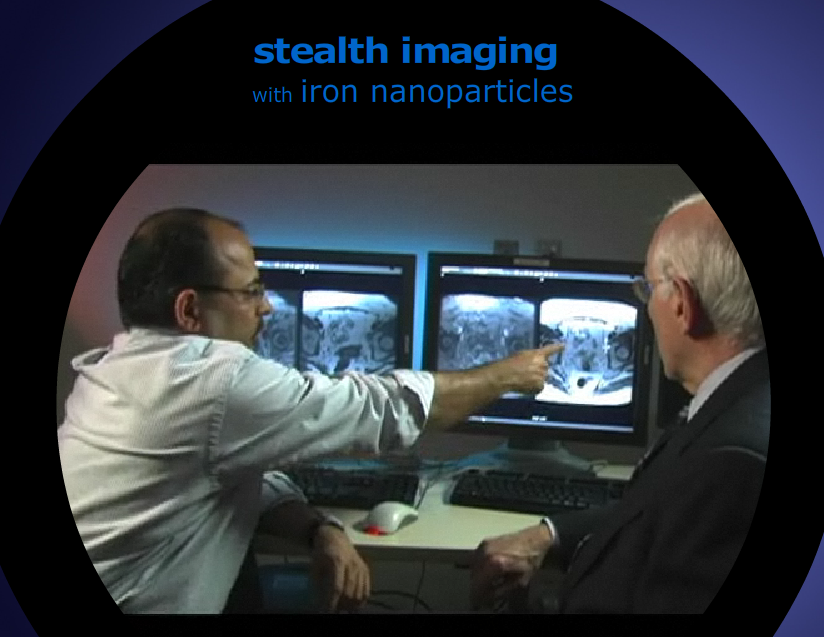DESCRIPTION
"Stealth Imaging with Iron Nanoparticles" is an 5-minute video that tells the research story of Ralph Weissleder and Mukesh Harisinghani, who collaborated on the design of a clinical trial to determine if an injection of specially-designed iron-oxide nanoparticles could enhance a diagnostic image produced by an MRI machine to the extent that the spread of cancer could be accurately assessed. At least in the case of prostate cancer, as Dr. Weissleder tells our producer in this story, "The results were stunning." Dr. Weissleder and Dr. Harisinghani's experimental cancer therapy is one of several new nanomedicine-based approaches to cancer treatment that is explored in the Nanomedicine Explorer kiosk, website and DVD (also on nisenet.org). The video, website and DVD are available in english and spanish. Contact Strategic Projects at the Museum of Science, Boston for the DVD ([email protected]).
DESCRIPTION
"Stealth Imaging with Iron Nanoparticles" is an 5-minute video that tells the research story of Ralph Weissleder and Mukesh Harisinghani, who collaborated on the design of a clinical trial to determine if an injection of specially-designed iron-oxide nanoparticles could enhance a diagnostic image produced by an MRI machine to the extent that the spread of cancer could be accurately assessed. At least in the case of prostate cancer, as Dr. Weissleder tells our producer in this story, "The results were stunning." Dr. Weissleder and Dr. Harisinghani's experimental cancer therapy is one of several new nanomedicine-based approaches to cancer treatment that is explored in the Nanomedicine Explorer kiosk, website and DVD (also on nisenet.org). The video, website and DVD are available in english and spanish. Contact Strategic Projects at the Museum of Science, Boston for the DVD ([email protected]).
TRAINING VIDEOS
OBJECTIVES
BIG IDEA
The field of nanomedicine is rapidly expanding and may soon bring us long-hoped for improvements in areas such as cancer detection and treatment. Researchers from different fields bring together their expertise to develop novel and sometimes revolutionary approaches to the detection and treatment of disease. All new approaches must go through rigorous safety and efficacy testing procedures in vitro, in animal models, and in clinical trials before being approved.
LEARNING GOALS
Nanomedicine is the application of nanotechnology to medicine.
Nanotechnology is the science of the small and the engineering and applications of very small structures.
Nanomedicine researchers develop tiny materials, tools and devices that can work with extreme precision at the nanoscale, the scale of the molecules and cells that make up our bodies.
Nanotechnology has created many materials and devices with unique and distinctive features - providing a new "toolbox" to try to address many medical needs.
Experts from a variety of backgrounds and in a range of different science and engineering disciplines are coming together to address these challenges.
Research involves creativity, discipline, teamwork and inspiration; it is often rewarding in personal as well as professional ways.
What cancer is, and how it grows and metastasizes.
All new techniques must go through years of testing to ensure that they will work and that they will be safe.
NANO CONTENT MAP
Scientists and engineers have formed the interdisciplinary field of nanotechnology by investigating properties and manipulating matter at the nanoscale.
Nanoscience, nanotechnology, and nanoengineering lead to new knowledge and innovations that weren't possible before.
DOWNLOAD FILES
Credits
Museum of Science
Developed with support from 3 sources: the NIH NCRR SEPA program; the NISE Network (NSF ESI 0532536); and the Center for High-rate Nanomanufacturing (NSF 0425826). Any opinions, findings, and conclusions or recommendations expressed in this product are those of the authors and do not necessarily reflect the views of the NSF, NIH or CHN.
Creative Commons Attribution Non-Commercial Share Alike 3.0 United States (CC BY-NC-SA 3.0 US).
View more details

NISE Network products are developed through an iterative collaborative process that includes scientific review, peer review, and visitor evaluation in accordance with an inclusive audiences approach. Products are designed to be easily edited and adapted for different audiences under a Creative Commons Attribution Non-Commercial Share Alike license. To learn more, visit our Development Process page.

